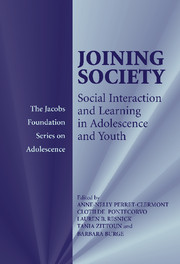Book contents
- Frontmatter
- Contents
- List of Contributors
- Foreword
- Preface
- I Introduction
- II Youth-Constructed Socialization
- 4 Risks, Rules, and Roles: Youth Perspectives on the Work of Learning for Community Development
- 5 Youth Between Integration and Disaffiliation in French Cities
- 6 A New Identity, A New Lifestyle
- 7 Becoming a Member by Following the Rules
- III Personal Agency Through Collective Activity
- IV Learning in Practice and Discourse
- V Intergenerational Sites for Thinking
- VI Pathways to Adulthood in National Context
- Index
- References
6 - A New Identity, A New Lifestyle
Published online by Cambridge University Press: 08 January 2010
- Frontmatter
- Contents
- List of Contributors
- Foreword
- Preface
- I Introduction
- II Youth-Constructed Socialization
- 4 Risks, Rules, and Roles: Youth Perspectives on the Work of Learning for Community Development
- 5 Youth Between Integration and Disaffiliation in French Cities
- 6 A New Identity, A New Lifestyle
- 7 Becoming a Member by Following the Rules
- III Personal Agency Through Collective Activity
- IV Learning in Practice and Discourse
- V Intergenerational Sites for Thinking
- VI Pathways to Adulthood in National Context
- Index
- References
Summary
Why arze good people unable to achieve for good what bad people can achieve for bad?
TolstoyIt is tempting to raise the same question when it comes to intervention in relation to teenagers and other youngsters who have developed a negative and delinquent lifestyle: Why are parents, educators, and social workers unable to achieve for good that which extreme youth movements seem to be able to achieve, sometimes for bad? Why do youngsters who are either unable to accept or opposed to normal codes of conduct and order sometimes become converts or get “snapped” into some extreme youth movement or sect where they seem to adapt and accept codes of conduct that can be far more demanding than the civil code they rejected earlier? Why are some of these movements successful in catching such youngsters psychologically, whereas the professional social and legal support systems very often seem to fail?
Some Examples of New Counterculture Youth Movements
What can we learn from studying these youth organizations? What do they offer that the professional social and educational support systems do not? Before proceeding, let us look at an example of what an insider of the house-culture reports on what is special about house parties:
It is where the music functions best, the atmosphere is highest, where sound and light together create a massive feeling of energy…. You do not need to invite anybody for dancing because everybody dances; it does not matter who you are or how you look, the important thing is that we all join in….[…]
- Type
- Chapter
- Information
- Joining SocietySocial Interaction and Learning in Adolescence and Youth, pp. 86 - 108Publisher: Cambridge University PressPrint publication year: 2003
References
- 1
- Cited by

